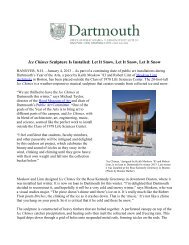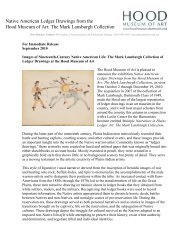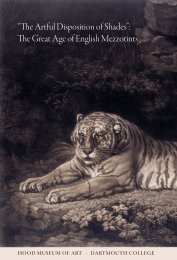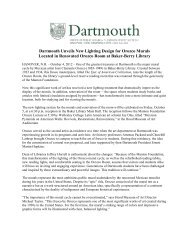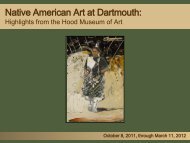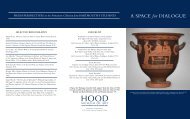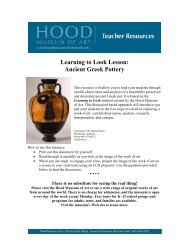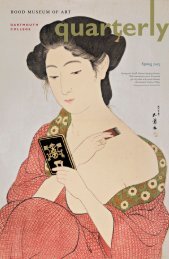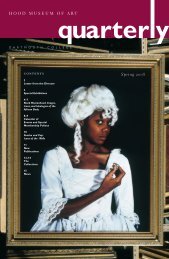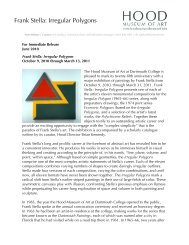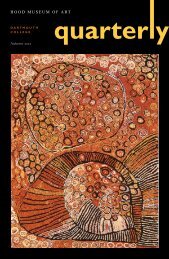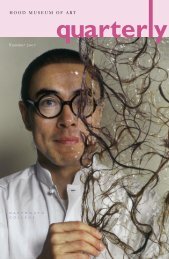Autumn 2007 - Hood Museum of Art - Dartmouth College
Autumn 2007 - Hood Museum of Art - Dartmouth College
Autumn 2007 - Hood Museum of Art - Dartmouth College
You also want an ePaper? Increase the reach of your titles
YUMPU automatically turns print PDFs into web optimized ePapers that Google loves.
HOOD MUSEUM OF ART<br />
quarter y<br />
D A R T M O U T H C O L L E G E<br />
<strong>Autumn</strong> <strong>2007</strong><br />
CONTENTS<br />
2 Letter from the Director<br />
3 Special Exhibitions<br />
4–7 Exhibition Features<br />
American Works on Paper to 1950:<br />
Highlights from the <strong>Hood</strong> <strong>Museum</strong> <strong>of</strong> <strong>Art</strong><br />
American <strong>Art</strong> at <strong>Dartmouth</strong>: Highlights from the<br />
<strong>Hood</strong> <strong>Museum</strong> <strong>of</strong> <strong>Art</strong><br />
No Laughing Matter: Visual Humor<br />
William Blake Engravings at Rauner Library<br />
Merce Cunningham at <strong>Dartmouth</strong><br />
8–9 Calendar <strong>of</strong> Events<br />
10 Wenda Gu:Transformations and Translations<br />
11 Philip H. Greene Donates California<br />
Watercolors, 1930–60<br />
12–13 The Collections<br />
14 Vital Support: Become a <strong>Hood</strong> <strong>Museum</strong><br />
<strong>of</strong> <strong>Art</strong> Member<br />
15 <strong>Museum</strong> News<br />
Millard Sheets, Camp Near Brawley, 1938, transparent watercolor<br />
over charcoal indications on very thick wove<br />
[Arches] paper. Partial and promised gift <strong>of</strong> Philip H. Greene<br />
in memory <strong>of</strong> his wife and co-collector, Marjorie B. Greene;<br />
EL.<strong>2007</strong>.6.12 (detail)
HOOD MUSEUM OF ART STAFF<br />
Gary Alafat, Security/Buildings Manager<br />
LETTER FROM THE DIRECTOR<br />
The exhibition American <strong>Art</strong> at <strong>Dartmouth</strong>: Highlights from the <strong>Hood</strong><br />
<strong>Museum</strong> <strong>of</strong> <strong>Art</strong>, which began last June, reaches fruition this fall with<br />
some fifty American works on paper joining the many paintings and<br />
pieces <strong>of</strong> sculpture and decorative arts already on display. A fine catalogue has<br />
been produced to coincide with the exhibition, and both are a testament to the<br />
curatorial talent and scholarship <strong>of</strong> Barbara MacAdam, Jonathan L. Cohen<br />
Curator <strong>of</strong> American <strong>Art</strong>. The exhibition and publication comprise the first in<br />
a series planned for the next few years that is focused on major aspects <strong>of</strong> the<br />
<strong>Hood</strong>’s permanent collections. This fulfills one <strong>of</strong> the key aims <strong>of</strong> the four-year<br />
Strategic Plan for the <strong>Hood</strong> that began on July 1, 2006. The staff and Board <strong>of</strong><br />
Overseers determined to heighten the museum’s visibility, increase academic<br />
and community programming, and reach outside the museum with exciting<br />
displays <strong>of</strong> works <strong>of</strong> art. The overall effect <strong>of</strong> these efforts has been remarkable<br />
already. Increased visibility has led to increased visitation, up 31 percent on the<br />
previous year, a consequence <strong>of</strong> much increased programming and many new<br />
initiatives by the staff. For example, Wenda Gu’s installations, united nations:<br />
the green house and united nations: united colors, on display in Baker-Berry<br />
Library until October 28, have caused much comment and debate in the campus<br />
and wider community. As <strong>College</strong> President James Wright said at the<br />
opening <strong>of</strong> the exhibition, contemporary art is meant to cause us to think, and<br />
there is no doubt that this engaging and provocative display will reverberate in<br />
the memory for a long time.<br />
<strong>Dartmouth</strong> has long had generous donors, and we are honored to acknowledge<br />
Philip Greene, who has made a delightful gift <strong>of</strong> thirteen paintings that demonstrate<br />
the best <strong>of</strong> California’s watercolorists from the late 1920s through the<br />
1950s. The gift was made in memory <strong>of</strong> Mr. Greene’s wife, Marjorie, who<br />
made the collection with him. The <strong>Hood</strong> has also been successful at auction<br />
in acquiring a fine portrait <strong>of</strong> William Legge, the Second Earl <strong>of</strong> <strong>Dartmouth</strong><br />
(1731–1801), the early benefactor after whom the <strong>College</strong> is named. The lifetime<br />
portrait by Pompeo Batoni, the most celebrated portrait painter in latereighteenth-century<br />
Rome, had remained in the sitter’s family since it was painted<br />
in the 1750s. Its purchase was made possible with funds received from Jane<br />
and David Dance D’40, T’41, Jonathan L. Cohen D’60, T’61, Frederick<br />
Whittemore D’53, T’54, Barbara Dau Southwell D’78 and David Southwell<br />
T’88, Jane and Raphael Bernstein DP, and an anonymous donor. Robert<br />
Dance ’77 provided decisive support, and the generous assistance <strong>of</strong> Joseph S.<br />
Caldwell III D’51, T’52 is also acknowledged. The <strong>Hood</strong> has thrived because <strong>of</strong><br />
the dedication and generosity <strong>of</strong> its friends and supporters. We are pleased that<br />
following the transition in 2006 to separate Boards for the <strong>Hood</strong> <strong>Museum</strong> <strong>of</strong><br />
<strong>Art</strong> and the Hopkins Center for the Performing <strong>Art</strong>s, there are now two distinct<br />
membership programs for our institutions as well. We look forward to building<br />
on the already strong community support for the <strong>Hood</strong> through our museum<br />
membership organization in the coming years. Thank you warmly for your<br />
great support <strong>of</strong> the museum and all it does to promote a spirit <strong>of</strong> creativity and<br />
imagination in our community.<br />
BRIAN KENNEDY<br />
Director<br />
Colored hair braid and stainlesssteel<br />
medallion (dnalnif = finland),<br />
detail from Wenda Gu’s united<br />
nations: united colors in Baker-<br />
Berry Library.<br />
Kristin Bergquist, School and Family Programs<br />
Coordinator<br />
Juliette Bianco, Assistant Director<br />
Amy Driscoll, Assistant Curator <strong>of</strong> Education<br />
Patrick Dunfey, Exhibitions Designer/Preparations<br />
Supervisor<br />
Rebecca Fawcett, Registrarial Assistant<br />
Kristin Monahan Garcia, Curatorial Assistant for<br />
Academic and Student Programming<br />
Cynthia Gilliland, Assistant Registrar<br />
Sharon Greene, Development Officer<br />
Kellen Haak, Collections Manager/Registrar<br />
Mary Ann Hankel, Exhibitions and Events<br />
Coordinator<br />
Katherine Hart, Associate Director and Barbara<br />
C. and Harvey P. <strong>Hood</strong> 1918 Curator <strong>of</strong> Academic<br />
Programming<br />
Deborah Haynes, Data Manager<br />
Alfredo Jurado, Security Guard<br />
Adrienne Kermond, Tour Coordinator<br />
Brian Kennedy, Director<br />
Phil Langan, Security Guard<br />
Barbara MacAdam, Jonathan L. Cohen Curator <strong>of</strong><br />
American <strong>Art</strong><br />
Christine MacDonald, Business Assistant<br />
Nancy McLain, Business Manager<br />
Nils Nadeau, Publications and Web Manager<br />
Kathleen O’Malley, Associate Registrar<br />
Robert Oxman, Security Guard<br />
Sharon Reed, Public Relations Coordinator<br />
John Reynolds, Lead Preparator<br />
Mary Ellen Rigby, Gift Shop Manager<br />
Roberta Shin, Executive Assistant<br />
Barbara Thompson, Curator <strong>of</strong> African, Oceanic,<br />
and Native American Collections<br />
T. Barton Thurber, Curator <strong>of</strong> European <strong>Art</strong><br />
Betsy Wakeman, Development Assistant<br />
Lesley Wellman, Curator <strong>of</strong> Education<br />
Kathryn Whittaker, Security Guard<br />
Janet Whyte, Security Guard<br />
Matthew Zayatz, Preparator<br />
<strong>Dartmouth</strong> <strong>College</strong><br />
Hanover, New Hampshire 03755<br />
(603) 646-2808<br />
<strong>Hood</strong> Quarterly #21 (<strong>Autumn</strong> <strong>2007</strong>)<br />
Edited by Nils Nadeau<br />
Designed by Joanna Bodenweber<br />
Printed by Villanti & Sons, Printers, Inc.<br />
2 HOOD QUARTERLY
SPECIAL<br />
exhibitions<br />
AMERICAN WORKS ON PAPER TO 1950:<br />
HIGHLIGHTS FROM THE HOOD MUSEUM OF ART<br />
September 22–December 9, <strong>2007</strong><br />
Complementing American <strong>Art</strong> at <strong>Dartmouth</strong>, this exhibition highlights the museum’s rich<br />
holdings <strong>of</strong> works on paper, including drawings, watercolors, prints, and photographs by such<br />
diverse artists as John James Audubon, Southworth and Hawes,William Trost Richards, James<br />
McNeill Whistler, Mary Cassatt, Lewis Hine, Childe Hassam, Stuart Davis, Edward Hopper,<br />
James Van Der Zee, Dorothea Lange, Grant Wood, and Jackson Pollock. See p. 4 for more<br />
information.<br />
John Sartain, after George Caleb Bingham; Publisher: Goupil & Co.; The County Election, 1854, handcolored engraving,<br />
mezzotint, and etching with stippling on wove paper. Purchased through the Julia L.Whittier Fund; PR.951.4.<br />
AMERICAN ART AT DARTMOUTH:<br />
HIGHLIGHTS FROM THE HOOD MUSEUM OF ART<br />
Through December 9, <strong>2007</strong><br />
American art has long been a mainstay <strong>of</strong> <strong>Dartmouth</strong> <strong>College</strong>’s collections, beginning<br />
with a gift in 1773 <strong>of</strong> a Boston-made silver bowl from Royal Governor John Wentworth<br />
to <strong>Dartmouth</strong>’s founder, Eleazar Wheelock, in honor <strong>of</strong> the <strong>College</strong>’s first commencement.The<br />
largest selection <strong>of</strong> the American collections ever presented at the <strong>Hood</strong>, this<br />
exhibition showcases over 150 paintings, sculptures, pieces <strong>of</strong> silver, and other decorative<br />
arts to 1950.<strong>Art</strong>ists represented include Paul Revere, John Singleton Copley, Gilbert<br />
Stuart,Thomas Doughty,Winslow Homer,Thomas Eakins, Frederic Remington,Willard<br />
Metcalf, Maria Oakey Dewing, John Sloan,Augusta Savage, Paul Sample, Maxfield Parrish,<br />
and Georgia O’Keeffe.An illustrated catalogue copublished with the University Press <strong>of</strong><br />
New England accompanies the exhibition. See p. 5 for more information.<br />
These exhibitions and their related publication were organized by the <strong>Hood</strong> <strong>Museum</strong> <strong>of</strong> <strong>Art</strong>, <strong>Dartmouth</strong> <strong>College</strong>, and are<br />
generously funded by the Bernard R. Siskind 1955 Fund, the Hansen Family Fund, the Leon C. 1927, Charles L. 1955, and<br />
Andrew J. 1984 Greenebaum Fund, and a generous gift from Jonathan L. Cohen, Class <strong>of</strong> 1960,Tuck 1961.<br />
Maria Oakey Dewing, Iris at Dawn, 1899, oil on canvas.<br />
Purchased through the Miriam and Sidney Stoneman<br />
Acquisition Fund and the Mrs. Harvey P. <strong>Hood</strong> W’18 Fund;<br />
P.999.11.<br />
WENDA GU<br />
united nations: the green house and<br />
united nations: united colors<br />
Site-Specific Installation in Baker<br />
Library’s Main Hall<br />
Through October 28, <strong>2007</strong><br />
The <strong>Hood</strong> <strong>Museum</strong> <strong>of</strong> <strong>Art</strong> and <strong>Dartmouth</strong><br />
<strong>College</strong> Library present a massive<br />
two-part installation by avant-garde<br />
Chinese artist Wenda Gu. Part <strong>of</strong> his<br />
ongoing global united nations hair monuments<br />
project, the green house and united<br />
colors were created from hair collected in<br />
2006 from thousands <strong>of</strong> <strong>Dartmouth</strong><br />
<strong>College</strong> students, faculty, and staff and<br />
Upper Connecticut River Valley community<br />
members. See p. 10.<br />
Organized by the <strong>Hood</strong> <strong>Museum</strong> <strong>of</strong> <strong>Art</strong>, <strong>Dartmouth</strong><br />
<strong>College</strong>, in partnership with the <strong>Dartmouth</strong> <strong>College</strong><br />
Library, and generously funded by a grant from the LEF<br />
Foundation, the William B. Jaffe and Evelyn A. Hall Fund,<br />
the Eleanor Smith Fund, and the George O. Southwick<br />
1957 Memorial Fund.<br />
NO LAUGHING MATTER:<br />
VISUAL HUMOR IN IDEAS OF<br />
RACE, NATIONALITY, AND<br />
ETHNICITY<br />
October 6, <strong>2007</strong>–January 13, 2008<br />
Harrington Gallery<br />
This exhibition accompanies <strong>Dartmouth</strong><br />
<strong>College</strong>’s Humanities Institute <strong>of</strong> the<br />
same name and displays objects and<br />
images that reflect visual humor’s role in<br />
disseminating ideas <strong>of</strong> race, nationality,<br />
and ethnicity. It includes anonymous<br />
broadsides, household objects, and comic<br />
stereographs, as well as works by eighteenth-century<br />
British satirists William<br />
Hogarth and James Gillray, nineteenthcentury<br />
Japanese woodcut artist<br />
Yoshimori, French caricaturist Honore<br />
Daumier, artist and illustrator Thomas<br />
Nast (considered the “father” <strong>of</strong> the<br />
American political cartoon), and many<br />
Bob Haozous, Apache<br />
Pull-Toy, 1988, painted<br />
steel. Purchased<br />
through the Joseph B.<br />
Obering ’56 Fund;<br />
S.989.17<br />
contemporary artists. Select works are<br />
also on loan from the Center for<br />
Cartoon Studies in White River Junction.<br />
See p. 6.<br />
Generously funded by the Harrington Gallery Fund.<br />
RESONANCE AND<br />
INSPIRATION: NEW WORKS<br />
BY MAGDALENE ODUNDO<br />
Through January 20, 2008<br />
Gutman Gallery<br />
Recent vessels and drawings by the<br />
Kenyan-born ceramic artist.<br />
Organized by the Samuel P. Harn <strong>Museum</strong> <strong>of</strong> <strong>Art</strong>,<br />
University <strong>of</strong> Florida.The presentation at the <strong>Hood</strong><br />
<strong>Museum</strong> <strong>of</strong> <strong>Art</strong> is generously funded by the William B.<br />
Jaffe and Evelyn A. Hall Fund.<br />
SELECTED EUROPEAN<br />
MASTERPIECES OF THE<br />
CURRIER MUSEUM OF ART<br />
Through September 23, <strong>2007</strong><br />
Harrington Gallery<br />
Objects on display range from Renaissance<br />
paintings to a rare modernist<br />
sculpture and include works by Jacob van<br />
Ruisdael, John Constable, and Pablo<br />
Picasso.<br />
Generously funded by the Harrington Gallery Fund.<br />
3
W ORKS ON PAPER E XHIBITION C APS C ELEBRATION<br />
OF H OOD’ S A MERICAN C OLLECTIONS<br />
B<br />
eginning September 22, the<br />
<strong>Hood</strong> will present more than<br />
fifty American drawings,<br />
watercolors, prints, and photographs from<br />
the collections in an exhibition entitled<br />
American Works on Paper to 1950:<br />
Highlights from the <strong>Hood</strong> <strong>Museum</strong> <strong>of</strong> <strong>Art</strong>.<br />
This presentation complements the larger<br />
exhibition <strong>of</strong> American paintings, sculptures,<br />
and decorative arts, American <strong>Art</strong> at<br />
<strong>Dartmouth</strong>: Highlights from the <strong>Hood</strong><br />
<strong>Museum</strong> <strong>of</strong> <strong>Art</strong>, that has been on view<br />
since June 9 in three galleries on the<br />
museum’s second level and in the Israel<br />
Sack Gallery on the museum’s entry<br />
level. Taken together, these exhibitions<br />
<strong>of</strong>fer by far the largest survey <strong>of</strong> <strong>Dartmouth</strong>’s<br />
American holdings to date while<br />
considering how and why these objects<br />
found their way to Hanover and how the<br />
American collections have developed further<br />
since the opening <strong>of</strong> the <strong>Hood</strong> in<br />
John James Audubon, American Buzzard or White<br />
Breasted Hawk . . ., c. 1810–20, pastel, graphite, chalk,<br />
and white opaque watercolor on medium-weight<br />
wove [J. Whatman] paper. Purchased through the<br />
Katharine T. and Merrill G. Beede 1929 Fund and<br />
the Mrs. Harvey P. <strong>Hood</strong> W’18 Fund; D.2003.52.<br />
1985. Text panels interspersed throughout<br />
the exhibitions present distinctive characteristics<br />
<strong>of</strong> the collection, including some<br />
<strong>of</strong> its primary modes <strong>of</strong> acquisition and its<br />
particular connections to <strong>Dartmouth</strong> and<br />
the region.<br />
Works on paper constitute a large proportion<br />
<strong>of</strong> the <strong>Hood</strong>’s American collections<br />
and are among the most frequently used<br />
works for teaching and exhibition. The<br />
<strong>College</strong> has actively collected prints,<br />
drawings, and watercolors since the early<br />
twentieth century. At that time a newly<br />
formed art department began to acquire,<br />
by gift and purchase, works that were<br />
deemed useful for didactic purposes and<br />
exhibition, particularly after the 1929<br />
opening <strong>of</strong> the Carpenter Hall art galleries.<br />
Such evidence <strong>of</strong> <strong>Dartmouth</strong>’s<br />
deepening commitment to the visual arts<br />
encouraged further donations, including<br />
the extraordinary 1935 gift from Abby<br />
Aldrich (Mrs. John Jr.) Rockefeller that<br />
included more than seventy-five<br />
American watercolors and drawings. The<br />
<strong>Hood</strong>’s impressive holdings in these<br />
Howard Norton Cook, Chrysler Building (Chrysler<br />
Building in Construction), 1930, wood engraving on<br />
Japanese paper. Purchased through a gift from the<br />
Estate <strong>of</strong> Russell Cowles, Class <strong>of</strong> 1909, and by<br />
exchange; PR.990.48<br />
media, strengthened by recent acquisitions,<br />
provided the subject for the museum’s<br />
2005 traveling exhibition and catalogue<br />
Marks <strong>of</strong> Distinction: Two Hundred<br />
Years <strong>of</strong> American Drawings and Watercolors<br />
from the <strong>Hood</strong> <strong>Museum</strong> <strong>of</strong> <strong>Art</strong>.<br />
The American print collection also<br />
began to develop early in the twentieth<br />
century and expanded rapidly in the<br />
1930s and 1940s, when the <strong>College</strong> purchased<br />
prints from such organizations as<br />
Associated American <strong>Art</strong>ists, which sold<br />
high-quality original prints to a large public<br />
at low cost, thereby supporting artists<br />
while popularizing American art.<br />
Sizeable gifts, such as Mrs. Hersey<br />
Egginton’s 1954 donation <strong>of</strong> over seven<br />
hundred works, primarily American<br />
prints from the first half <strong>of</strong> the twentieth<br />
century, bolstered these holdings, which<br />
now number almost three thousand<br />
examples before 1950.<br />
Although it wasn’t until the 1970s that<br />
<strong>Dartmouth</strong> began collecting photography<br />
in a deliberate and concerted manner,<br />
such photographs as a Southworth and<br />
Hawes daguerreotype <strong>of</strong> Daniel Webster<br />
found their way to <strong>Dartmouth</strong> as early as<br />
the mid-nineteenth century. Thanks to<br />
continuing gifts and the availability <strong>of</strong><br />
acquisitions funds established since the<br />
<strong>Hood</strong>’s opening, the photography collections<br />
have grown rapidly in recent<br />
decades. The museum’s curators have<br />
particularly sought out photographs<br />
4
A MERICAN A RT AT D ARTMOUTH<br />
Highlights from the <strong>Hood</strong> <strong>Museum</strong> <strong>of</strong> <strong>Art</strong><br />
considered useful for teaching not<br />
only the practice and history <strong>of</strong> photography<br />
but also a number <strong>of</strong> academic<br />
disciplines, including American<br />
history. Recently acquired iconic documentary<br />
photographs by Lewis Hine<br />
(shown here) and Dorothea Lange, for<br />
instance, serve not only as cornerstone<br />
images in the history <strong>of</strong> American<br />
photography but also as key documents<br />
pertaining to child labor and<br />
the Great Depression, respectively.<br />
As is the case with its companion exhibition<br />
<strong>of</strong> American paintings, sculpture,<br />
and decorative arts, American<br />
Works <strong>of</strong> <strong>Art</strong> on Paper to 1950 can only<br />
hint at the quality, diversity, and<br />
breadth <strong>of</strong> the <strong>Hood</strong> collections.<br />
Owing to space limitations and the<br />
susceptibility <strong>of</strong> works on paper to<br />
damage from light exposure, only a<br />
fraction <strong>of</strong> these objects can be on<br />
public view at any given time. Both<br />
exhibitions continue through<br />
December 9. In conjunction with<br />
them, the museum has produced a<br />
256-page book on the American collections—the<br />
first in a series <strong>of</strong> publications<br />
the <strong>Hood</strong> will issue over the<br />
next several years devoted to aspects <strong>of</strong><br />
the museum’s greatest assets, its permanent<br />
collections. Copublished with<br />
the University Press <strong>of</strong> New England,<br />
this fully illustrated book features<br />
individual entries for more than two<br />
hundred works from the American<br />
collections dating from around 1705<br />
to 1950, many <strong>of</strong> which have never<br />
before been published. An introductory<br />
essay surveys the formation <strong>of</strong> the<br />
collection and its changing focus<br />
and function over the course <strong>of</strong> <strong>Dartmouth</strong>’s<br />
long history. Contact the<br />
<strong>Museum</strong> Shop at (603) 646-2317.<br />
BARBARA J. MACADAM<br />
Jonathan L. Cohen Curator <strong>of</strong><br />
American <strong>Art</strong><br />
C<br />
ontinuing through the fall, the<br />
<strong>Hood</strong> presents the largest selec<br />
tion ever—over 150 paintings,<br />
sculptures, silver pieces, and other decorative<br />
arts—from its rich holdings <strong>of</strong><br />
American art dating before 1950. These<br />
collections, which now number more<br />
than eight thousand objects, began with<br />
a gift in 1773 <strong>of</strong> a Boston-made silver<br />
bowl given by Royal Governor John<br />
Wentworth to <strong>Dartmouth</strong>’s founder,<br />
Eleazar Wheelock, in honor <strong>of</strong> the<br />
<strong>College</strong>’s first commencement. Thanks<br />
to the generosity <strong>of</strong> <strong>Dartmouth</strong> alumni<br />
and friends and purchases made by<br />
museum staff, these holdings have grown<br />
dramatically in the intervening years,<br />
especially since the opening <strong>of</strong> the <strong>Hood</strong><br />
<strong>Museum</strong> <strong>of</strong> <strong>Art</strong> in 1985. Whereas the<br />
<strong>College</strong> initially collected primarily<br />
American portraits to commemorate<br />
<strong>Dartmouth</strong> luminaries such as Wheelock<br />
and statesman Daniel Webster, Class <strong>of</strong><br />
1801, the collection broadened with the<br />
early-twentieth-century growth <strong>of</strong> the<br />
<strong>College</strong>’s art department and the increasing<br />
visibility <strong>of</strong> the fine arts on campus,<br />
including the opening <strong>of</strong> art galleries in<br />
Carpenter Hall in 1929, the Hopkins<br />
Center in 1962, and the <strong>Hood</strong> in 1985.<br />
Now not only larger but more varied in<br />
nature, the American collections are<br />
used by faculty from many academic<br />
departments for teaching and research,<br />
and by diverse audiences well beyond the<br />
<strong>College</strong> community and its environs.<br />
Many <strong>of</strong> the strengths <strong>of</strong> the collection<br />
reflect the museum’s associations with<br />
<strong>Dartmouth</strong> and its location in northern<br />
New England. In addition to portraits,<br />
the painting collection is strong in New<br />
England landscapes, particularly views <strong>of</strong><br />
New Hampshire’s White Mountains. It<br />
also includes important examples <strong>of</strong><br />
nineteenth-century genre painting and<br />
early-twentieth-century impressionism,<br />
social realism, and modernism.<br />
Harriet Hosmer, Medusa, c. 1854, marble. Purchased<br />
through a gift from Jane and W. David Dance, Class<br />
<strong>of</strong> 1940; S.996.24.<br />
Highlights include works by Gilbert<br />
Stuart, Thomas Sully, Winslow Homer,<br />
Thomas Eakins, Frederic Remington,<br />
Maria Oakey Dewing, Willard Metcalf,<br />
John Sloan (who was cousin to<br />
<strong>Dartmouth</strong> president John Sloan<br />
Dickey), Georgia O’Keeffe, Paul Sample,<br />
Maxfield Parrish, Adolph Gottlieb, and a<br />
newly acquired early work by Jackson<br />
Pollock. Sculpture highlights include<br />
works by Harriet Hosmer, Augustus Saint-<br />
Gaudens, Augusta Savage, and Paul<br />
Manship. In the decorative arts, the<br />
<strong>Hood</strong>’s collections boast an outstanding<br />
representation <strong>of</strong> colonial Massachusetts<br />
silver and smaller holdings <strong>of</strong> American<br />
pewter, glass, and textiles. The furniture<br />
holdings include a particularly fine group<br />
<strong>of</strong> Boston neoclassical pieces that formerly<br />
belonged to George Ticknor, Class <strong>of</strong><br />
1807, and Shaker furniture from Enfield,<br />
New Hampshire. Finally, two exceptional<br />
examples <strong>of</strong> Grueby pottery represent the<br />
high point <strong>of</strong> New England ceramics in<br />
the <strong>Art</strong>s and Crafts style.<br />
PEOPLE’S PICKS<br />
What is your favorite work <strong>of</strong> American art at the <strong>Hood</strong> Starting September 1, use our<br />
gallery ballots to choose your favorite and tell us why you like it.Visitor responses will be<br />
published on our Web site and in the galleries, and in November, members <strong>of</strong> the <strong>Hood</strong><br />
staff will <strong>of</strong>fer four People’s Picks tours highlighting works chosen by our visitors.To learn<br />
more about this project and see what other people are choosing, please visit our Web site<br />
at hoodmuseum.dartmouth.edu.<br />
Lewis Wickes Hine, Breaker Boys, 1911; print<br />
1911–30, gelatin silver print. Purchased through<br />
the Katharine T. and Merrill G. Beede 1929<br />
Fund; 2005.12.<br />
People’s Picks tours:<br />
Wednesday, November 14, at 5:00 P.M.<br />
Tuesday, November 20, at 12:30 P.M.<br />
Thursday, November 29, at 12:30 P.M.<br />
Saturday, December 1, at 2:00 P.M.<br />
HOOD QUARTERLY 5
NO LAUGHING MATTER:<br />
VISUAL HUMOR IN IDEAS OF RACE,<br />
NATIONALITY, AND ETHNICITY<br />
October 6–December 2, <strong>2007</strong><br />
Harrington Gallery<br />
This fall term, <strong>Dartmouth</strong> <strong>College</strong> Humanities Institute participants, including visiting<br />
residential fellows and several <strong>Dartmouth</strong> faculty members, are meeting weekly on campus<br />
to investigate the impact <strong>of</strong> visual humor on history, psychology, culture, and everyday<br />
life from multiple perspectives. No Laughing Matter is led by David Bindman (Morton<br />
Distinguished Fellow) and Angela Rosenthal (<strong>Dartmouth</strong> Institute Director), under the<br />
auspices <strong>of</strong> the Leslie Center for the Humanities, <strong>Dartmouth</strong> <strong>College</strong>, with the participation<br />
<strong>of</strong> the Yale Center for British <strong>Art</strong> and the Du Bois Institute <strong>of</strong> African and<br />
African-American Studies at Harvard.The Humanities Institute will host an international<br />
conference, November 8–10, <strong>2007</strong>.The <strong>Hood</strong> exhibition has also been organized in<br />
conjunction with the Northeast American Society for Eighteenth-Century Studies<br />
Annual Meeting and conference, October 25–28, <strong>2007</strong>, which will host a special panel<br />
titled Visual Humor in the Global Eighteenth Century in conjunction with the Humanities<br />
Institute. Labels for the exhibition will be written by fellows, faculty, and <strong>Hood</strong> staff. For<br />
more information on public programs <strong>of</strong>fered in conjunction with the institute, visit<br />
www.dartmouth.edu/~lhc.<br />
The Institute explores the uses and abuses <strong>of</strong> humor in representations <strong>of</strong> different<br />
peoples <strong>of</strong> the world in all media and during all periods.The exhibition, drawn primarily<br />
from the museum’s collections, focuses on prints and photographs from the eighteenth<br />
century to the present day. It does not address one “race” or nationality but demonstrates<br />
that humorous stereotyping has been employed to represent different groups<br />
that only in the nineteenth century were separated out into races. If the media used<br />
vary, then so do the methods <strong>of</strong> ridicule.All, however, involve a reduction <strong>of</strong> the subject<br />
to a limited number <strong>of</strong> easily grasped generalities that are both powerful and pernicious.The<br />
contemporary artists in the exhibition have sought to demonstrate and<br />
counteract the continuing influence <strong>of</strong> such imagery, by exposure, irony, and appropriation,<br />
in some cases even inverting the stereotypes. Many <strong>of</strong> the images are now seen as<br />
deeply <strong>of</strong>fensive, but it is nonetheless important to look historically and critically at<br />
what would have been a daily reality in the not too distant past, and at the stereotypes<br />
that continue to haunt us today. ■<br />
North America, Northwest Coast, Canada, British Columbia, Haida (), miniature figure <strong>of</strong> missionary, 1820–60,<br />
wood, bone, and black pigment. Gift <strong>of</strong> Mrs. Margaret Kimberly; 22.3.1877<br />
BLAKE ENGRAVINGS AT RAUNER LIBRARY<br />
November 26, <strong>2007</strong>–January 31, 2008<br />
Rauner Special Collections Library<br />
November 20, <strong>2007</strong>–January 13, 2008<br />
<strong>Hood</strong> <strong>Museum</strong> <strong>of</strong> <strong>Art</strong><br />
In celebration <strong>of</strong> the 250th anniversary <strong>of</strong> the birth <strong>of</strong> poet, artist, and printer William<br />
Blake, the <strong>Hood</strong> <strong>Museum</strong> <strong>of</strong> <strong>Art</strong> and <strong>Dartmouth</strong>’s Rauner Special Collections Library<br />
will display some <strong>of</strong> his rare masterpieces from their collections.The four engravings in<br />
the <strong>Hood</strong>’s collection from Blake’s series illustrating Dante’s Inferno were not published<br />
until 1838, after the artist’s death.The Rauner Library exhibit, curated by English<br />
Language and Literature Librarian Laura Braunstein, will feature illustrated books and<br />
other materials, including a pro<strong>of</strong>-set <strong>of</strong> Blake’s illustrations to the Book <strong>of</strong> Job and a<br />
stunning full-color facsimile <strong>of</strong> Blake’s Paradise Lost illustrations. ■<br />
William Blake, The Circle <strong>of</strong> the Corrupt Officials . . . from Dante’s Divine Comedy, 1827, engraving. Gift <strong>of</strong> Jean K.Weil<br />
in memory <strong>of</strong> Adolph Weil Jr., Class <strong>of</strong> 1935; PR.997.5.118.<br />
6 HOOD QUARTERLY
MERCE CUNNINGHAM AT DARTMOUTH<br />
This past April, the <strong>Hood</strong> <strong>Museum</strong> <strong>of</strong> <strong>Art</strong> joined the campus-wide celebration <strong>of</strong> the<br />
Montgomery Endowment’s residency <strong>of</strong> dance pioneers Pilobolus with the exhibition<br />
Pilobolus Comes Home:Three Decades <strong>of</strong> Dance Photographs. The photographs displayed<br />
in the exhibition, works <strong>of</strong> art in their own right, reinforced the connection between<br />
choreography and art.This fall, these connections will be made anew when Merce<br />
Cunningham, one <strong>of</strong> the world’s most renowned living choreographers, comes to<br />
<strong>Dartmouth</strong> as a Montgomery Fellow. Mr. Cunningham will be honored by the <strong>Hood</strong><br />
this October as the subject <strong>of</strong> the Dr. Allen W. Root Contemporary <strong>Art</strong> Distinguished<br />
Lecture, as well as with an outdoor exhibition <strong>of</strong> a Cunningham dance film.<br />
Merce Cunningham began choreographing independently after five years as a soloist in<br />
the Martha Graham Dance Company, founding his own company in 1953. Like Pilobolus,<br />
Mr. Cunningham used art as an inspiration and springboard for creative experimentation<br />
through collaborations that greatly impacted both dance and art history. His<br />
artistic partnerships will be illuminated by Bonnie Clearwater, Executive Director and<br />
Chief Curator <strong>of</strong> the <strong>Museum</strong> <strong>of</strong> Contemporary <strong>Art</strong>, North Miami, in the public Dr.<br />
Allen W. Root lecture “Dancing on the Cutting Edge: Merce Cunningham” on Wednesday,<br />
October 10, at 5:30 p.m. in the Loew Auditorium.<br />
During Mr. Cunningham’s residency, the <strong>Hood</strong> <strong>Museum</strong> <strong>of</strong> <strong>Art</strong> will project video footage<br />
<strong>of</strong> Channels/Inserts, a dance film produced by the Cunningham Dance Foundation in<br />
1982, onto a wall in the Bedford Courtyard. Literally connecting Cunningham’s work<br />
with the museum, the <strong>Hood</strong> hopes this unconventional projection will provide an<br />
appropriate framework and backdrop for the residency <strong>of</strong> a truly iconic dancer, visionary,<br />
and choreographer. ■<br />
KRISTIN MONAHAN GARCIA<br />
Curatorial Assistant for Academic and Student Programming<br />
The Merce Cunningham Dance Company will hold performances at 8 p.m. on Friday, October 5, and 2 p.m. and<br />
8 p.m. on Saturday, October 6, in the Moore Theater <strong>of</strong> <strong>Dartmouth</strong>’s Hopkins Center.These performances will<br />
premiere XOVER, a work that has been co-commissioned by the Hopkins Center and will feature costumes by<br />
Robert Rauschenberg and music by John Cage.The Montgomery Fellow Lecture,“In Conversation with Merce<br />
Cunningham,” will be held on Wednesday, October 3, at 7:00 p.m. in Moore Theater (free and open to the public).A<br />
reception will follow in the Top <strong>of</strong> the Hop.<br />
Mr. Cunningham’s Montgomery Fellowship is made possible by the Kenneth and Harle Montgomery Endowment,<br />
and the company’s residency has received substantial support from the Marion and Frederick Whittemore 1953<br />
Distinguished <strong>Art</strong>ist Series Fund at the Hopkins Center.<br />
Photograph <strong>of</strong> Merce Cunningham Dance Company by Anna Finke.<br />
Photograph <strong>of</strong> Merce Cunningham by Mark Seliger.<br />
HOOD QUARTERLY 7
calendar <strong>of</strong><br />
events<br />
Public programs are made possible with support<br />
from the <strong>Hood</strong> <strong>Museum</strong> <strong>of</strong> <strong>Art</strong> Membership<br />
Program.<br />
SEPTEMBER<br />
29 September, Saturday, 2:00 P.M.<br />
Introductory Tour <strong>of</strong> American <strong>Art</strong> at <strong>Dartmouth</strong><br />
OCTOBER<br />
2 October,Tuesday, 12:30 P.M.<br />
Kim Gallery<br />
Lunchtime Gallery Talk<br />
HARLEM RENAISSANCE ART AT THE HOOD:<br />
WORKS BY AUGUSTA SAVAGE, HENRY BANNARN,<br />
AND JAMES VAN DER ZEE<br />
Phoebe Wolfskill, Andrew W. Mellon Postdoctoral Fellow<br />
6 October, Saturday, 2:00 P.M.<br />
Main corridor <strong>of</strong> Baker Library<br />
Introductory Tour <strong>of</strong> united nations: the green house<br />
and united nations: united colors<br />
Juliette Bianco, Assistant Director<br />
10 October,Wednesday, 5:30 P.M.<br />
<strong>Art</strong>hur M. Loew Auditorium<br />
The Dr. Allen W. Root Contemporary <strong>Art</strong><br />
Distinguished Lecture<br />
DANCING ON THE CUTTING EDGE:<br />
MERCE CUNNINGHAM<br />
Bonnie Clearwater, Executive Director and Chief Curator,<br />
<strong>Museum</strong> <strong>of</strong> Contemporary <strong>Art</strong>, North Miami, and curator <strong>of</strong><br />
a recent exhibition about Cunningham’s collaborations with<br />
visual artists. A reception will follow in Kim Gallery. Offered<br />
in conjunction with the <strong>Hood</strong>’s Merce Cunningham installation<br />
and Mr. Cunningham’s Montgomery Fellowship. Also<br />
see p.7.<br />
13 October, Saturday, 2:00 P.M.<br />
<strong>Hood</strong> Highlights Tour<br />
Explore a selection <strong>of</strong> objects in the museum’s collection<br />
with an experienced guide.<br />
14 October, Sunday, 12:00 noon–5:00 P.M.<br />
Family Day<br />
EXPLORING AMERICAN ART!<br />
Enjoy a fun-filled afternoon looking at works <strong>of</strong> art that tell<br />
stories about life in America from the 1770s through the<br />
1950s, including portraits <strong>of</strong> children, paintings <strong>of</strong> outdoor<br />
places in rural and urban America, and a variety <strong>of</strong> household<br />
objects.Write and draw in a variety <strong>of</strong> special family<br />
brochures that you can take home. In the studio, paint your<br />
own picture <strong>of</strong> American life on canvas. For children ages 6<br />
to 12 and their adult companions. No pre-registration<br />
required. For information, call (603) 646-1469.<br />
16 October,Tuesday, 12:30 P.M.<br />
Second-floor galleries<br />
Lunchtime Gallery Talk<br />
FROM THE WHITE MOUNTAINS TO PAUL SAMPLE:<br />
REGIONAL CONNECTIONS IN AMERICAN ART AT<br />
DARTMOUTH<br />
Barbara J. MacAdam, Jonathan L. Cohen Curator<br />
<strong>of</strong> American <strong>Art</strong><br />
19 October, Friday, 4:30 P.M.<br />
<strong>Art</strong>hur M. Loew Auditorium<br />
Lecture and Reception<br />
AMERICAN ART:TELLING ITS STORY<br />
Elizabeth Johns, Pr<strong>of</strong>essor Emerita, History <strong>of</strong> <strong>Art</strong>,<br />
University <strong>of</strong> Pennsylvania<br />
20 October, Saturday, 2:00 P.M.<br />
Introductory Tour <strong>of</strong> American Works on Paper to 1950<br />
23 October,Tuesday, 12:30 P.M.<br />
Gutman Gallery<br />
Lunchtime Gallery Talk<br />
AFRICAN MUSES IN THE CERAMICS OF<br />
MAGDALENE ODUNDO<br />
Barbara Thompson, Curator <strong>of</strong> African, Oceanic,<br />
and Native American Collections<br />
26 October, Friday, 7:30 P.M.<br />
<strong>Art</strong>hur M. Loew Auditorium<br />
Film Screening<br />
OROZCO: MAN OF FIRE<br />
(2006, 57:42 min., narrated by Angelica Houston)<br />
Directors Laurie Coyle and Rick Tejada-Flores create a<br />
visually arresting and whimsical documentary portrait <strong>of</strong> the<br />
great Mexican muralist. Laurie Coyle will introduce the film<br />
and answer audience questions afterward.<br />
27 October, Saturday, 2:00 P.M.<br />
Main corridor <strong>of</strong> Baker Library<br />
Introductory Tour <strong>of</strong> united nations: the green house<br />
and united nations: united colors<br />
Brian Kennedy, Director<br />
30 October,Tuesday, 12:30 P.M.<br />
Reserve corridor, Baker Library<br />
Lunchtime Gallery Talk<br />
JACKSON POLLOCK’S BALD WOMAN WITH<br />
SKELETON<br />
Brian Kennedy, Director<br />
NOVEMBER<br />
3 November, Saturday, 2:00 P.M.<br />
<strong>Art</strong>hur M. Loew Auditorium<br />
Lecture and Object Identification Session<br />
TREASURES OF AMERICAN GLASS THROUGH<br />
FOUR CENTURIES<br />
Kirk J. Nelson, Executive Director,The New Bedford <strong>Museum</strong><br />
<strong>of</strong> Glass, New Bedford, Massachusetts. Following his lecture,<br />
Mr. Nelson will be available to identify (but not appraise)<br />
pieces <strong>of</strong> American glass brought by audience members.<br />
Limit one object per person.<br />
8 November,Thursday, 4:30 P.M.<br />
<strong>Art</strong>hur M. Loew Auditorium<br />
Lecture/Keynote Address for the Conference<br />
No Laughing Matter<br />
CARNIVALESQUE AND GROTESQUE:<br />
WHAT BAKHTIN'S LAUGHTER TELLS US ABOUT<br />
ART AND CULTURE<br />
Kobena Mercer, Independent Scholar, United Kingdom<br />
Sponsored by the Leslie Center for the Humanities, <strong>Dartmouth</strong><br />
<strong>College</strong>. For details on the international conference<br />
hosted by the Humanities Institute, November 8–10, please<br />
see the Leslie Center’s Web site: www.dartmouth.edu/~lhc.<br />
Also see p. 6.<br />
8 HOOD QUARTERLY
10 November, Saturday 2:00 P.M.<br />
Introductory Tour <strong>of</strong> Resonance and Inspiration<br />
13 November,Tuesday, 12:30 P.M.<br />
Second-Floor Galleries<br />
Lunchtime Gallery Talk<br />
TEACHING WITH THE HOOD MUSEUM’S<br />
AMERICAN ART COLLECTION:<br />
THE SOCIAL-HISTORICAL PERSPECTIVE<br />
Mary C<strong>of</strong>fey,Assistant Pr<strong>of</strong>essor <strong>of</strong> <strong>Art</strong> History<br />
14 November,Wednesday, 4:00–9:00 P.M.<br />
MORE FOR MEMBERS:<br />
Members’ Night at the <strong>Hood</strong> <strong>Museum</strong> <strong>of</strong> <strong>Art</strong> Shop<br />
This is a special opportunity for <strong>Hood</strong> Members to preview,<br />
shop, and receive 20% <strong>of</strong>f all purchases the evening before<br />
the <strong>Hood</strong> Holiday Sale.With every purchase, members will<br />
be entered in a raffle for a special out-<strong>of</strong> print book. Not<br />
a member yet Join on or before November 13 or 14 and<br />
receive 20% <strong>of</strong>f your purchases for these two days. Call<br />
603-646-2808.<br />
14 November,Wednesday, 5:00 P.M.<br />
<strong>Museum</strong> Galleries<br />
People’s Picks Tour<br />
Barbara J. MacAdam, Jonathan L. Cohen Curator <strong>of</strong> American<br />
<strong>Art</strong>, will lead a tour <strong>of</strong> American <strong>Art</strong> at <strong>Dartmouth</strong> featuring<br />
works chosen by our visitors.To learn more about how you<br />
can vote for your favorite work <strong>of</strong> American art at the <strong>Hood</strong>,<br />
visit the museum or www.hoodmuseum.dartmouth. edu.<br />
15 November,Thursday, 11:00 A.M.–5:00 P.M.<br />
HOOD HOLIDAY SALE<br />
<strong>Hood</strong> <strong>Museum</strong> Shop<br />
Get your holiday shopping done early and enjoy treats and<br />
refreshments!<br />
16 November, Friday, 4:30 P.M.<br />
<strong>Art</strong>hur M. Loew Auditorium<br />
Lecture<br />
CONNECTICUT VALLEY FURNITURE: URBAN<br />
STYLES FOR A RURAL SOCIETY, 1650–1850<br />
Philip Zea, President, Historic Deerfield<br />
17 November, Saturday, 2:00 P.M.<br />
<strong>Hood</strong> Highlights Tour<br />
Explore a selection <strong>of</strong> objects in the museum’s collection<br />
with an experienced guide.<br />
18 November, Sunday, 1:00–3:00 P.M.<br />
Children’s Program<br />
TELL A STORY OF ART<br />
Explore how stories are told in art through a variety <strong>of</strong> writing<br />
and discussion activities. Participants will look at art<br />
throughout the museum and then create a handmade book<br />
in the studio for their own drawings and stories. Open to<br />
children ages 8 to 11. Registration limited to 20. For more<br />
information or to register, please call (603) 646-1469.<br />
20 November,Tuesday, 12:30 P.M.<br />
<strong>Museum</strong> Galleries<br />
People’s Picks Tour<br />
Katherine Hart, Associate Director and Barbara C. and<br />
Harvey P. <strong>Hood</strong> Curator <strong>of</strong> Academic Programming, will lead<br />
a tour <strong>of</strong> American <strong>Art</strong> at <strong>Dartmouth</strong> featuring works chosen<br />
by our visitors.<br />
29 November,Thursday, 12:30 P.M.<br />
<strong>Museum</strong> Galleries<br />
People’s Picks Tour<br />
Lesley Wellman, Curator <strong>of</strong> Education, will lead a tour <strong>of</strong><br />
American <strong>Art</strong> at <strong>Dartmouth</strong> featuring works chosen by our<br />
visitors.<br />
30 November, Friday, 4:30 P.M.<br />
<strong>Art</strong>hur M. Loew Auditorium<br />
Lecture<br />
HOW DO WE LEARN TO READ PICTURES<br />
James A.W. Heffernan, Emeritus Pr<strong>of</strong>essor <strong>of</strong> English<br />
DECEMBER<br />
1 December, Saturday, 2:00 P.M.<br />
<strong>Museum</strong> Galleries<br />
People’s Picks Tour<br />
Amy Driscoll, Assistant Curator <strong>of</strong> Education, will lead a<br />
tour <strong>of</strong> American <strong>Art</strong> at <strong>Dartmouth</strong> featuring works chosen<br />
by our visitors.<br />
5 December,Wednesday, 5:30–7:30 P.M.<br />
Holiday Open House<br />
This annual favorite is an opportunity to kick <strong>of</strong>f the holiday<br />
season while surrounded by inspiring art. Enjoy refreshments<br />
and light snacks in Kim Gallery and live performances in<br />
Loew Auditorium.This event is free and open to the public.<br />
8 December, Saturday, 2:00 P.M.<br />
Introductory Tour <strong>of</strong> American <strong>Art</strong> at <strong>Dartmouth</strong><br />
ARTVENTURES<br />
Interactive tours for children ages eight and older are<br />
<strong>of</strong>fered on the first Saturday <strong>of</strong> each month, October<br />
through May. Limited to 20 children on a pre-registration<br />
basis. For information, call the museum’s Education<br />
Department at (603) 646-1469.<br />
GROUP TOURS<br />
Free guided tours <strong>of</strong> the museum’s collections and<br />
exhibitions are available by appointment. Contact us at<br />
(603) 646-1469 or hood.museum.tours@dartmouth.edu.<br />
The museum is open every Wednesday evening until<br />
9:00 P.M., so please visit after work!<br />
All museum exhibitions and events are free and open to the public<br />
unless otherwise noted. For the safety <strong>of</strong> all <strong>of</strong> our visitors, the <strong>Hood</strong><br />
<strong>Museum</strong> <strong>of</strong> <strong>Art</strong> will enforce legal seating capacity limits at every event<br />
in accordance with RSA 153:5 and Life Safety Code 101.<br />
Assistive listening devices are available for all events.<br />
The museum, including the <strong>Art</strong>hur M. Loew Auditorium, is<br />
wheelchair accessible. For accessibility requests, please call<br />
603-646-2809 or e-mail Access-<strong>Hood</strong>@Mac.<strong>Dartmouth</strong>.edu<br />
HOOD QUARTERLY 9
WENDA GU<br />
(upper left) The installation united<br />
nations: united colors in Berry Library,<br />
which counters talk <strong>of</strong> globalization<br />
by demonstrating how the number<br />
<strong>of</strong> countries in the world keeps<br />
increasing.<br />
(lower left) The installation united<br />
nations: the green house in Baker<br />
Library: natural light reveals the<br />
textures <strong>of</strong> the hair screens.<br />
(upper right) Visitors gather around<br />
united nations: the green house for the<br />
opening ceremonies on June 6, <strong>2007</strong>.<br />
Photo by Kawakahi Amina '09.<br />
10 HOOD QUARTERLY<br />
TRANSFORMATIONS AND TRANSLATIONS<br />
THE ART OF WENDA GU is founded in the<br />
history, culture, and traditions <strong>of</strong> his native<br />
China. He has been preoccupied artistically<br />
with finding contemporary and global applications<br />
for the knowledge and skills he has<br />
learned about Chinese traditions <strong>of</strong> printmaking<br />
and bookbinding, the carving <strong>of</strong> stone steles<br />
and the building <strong>of</strong> great walls, the writing<br />
<strong>of</strong> Tang poetry, and the design <strong>of</strong> political<br />
posters. He has explored these traditions in<br />
radical ways through various media, including<br />
calligraphy, ink drawing, sculptural installation,<br />
electronic multimedia, and performance art. In<br />
a vigorous embrace <strong>of</strong> the contemporary art<br />
market’s models <strong>of</strong> exhibition and promotion,<br />
he has shown his work in commercial and<br />
museum galleries, in artist-run spaces, and at<br />
the major art biennials and triennials <strong>of</strong> the<br />
world. Wenda Gu’s artistic practice is inextricably<br />
linked to his migrant identity as a Chineseborn<br />
and trained artist who came to the West<br />
in search <strong>of</strong> the “American dream.” His work<br />
engages constantly with the comparisons and<br />
contradictions between his upbringing and<br />
training in communist China and the circumstances<br />
<strong>of</strong> his life after he settled in 1987 in<br />
the world’s most multicultural city and the<br />
leading center <strong>of</strong> capitalist America, New York.<br />
In a unique fashion Wenda Gu brings together<br />
particular characteristics <strong>of</strong> practice that are to<br />
varying degrees typical <strong>of</strong> contemporary artists<br />
internationally. First, he views his art making<br />
as “truly international,” embracing all cultures.<br />
Second, he uses text and the distortion or corruption<br />
<strong>of</strong> language as a device or format to<br />
present his concept <strong>of</strong> contemporary culture.<br />
Third, he favors human body material as his<br />
medium. Fourth, he embraces the involvement<br />
<strong>of</strong> the public in the process <strong>of</strong> his art making<br />
while employing many assistants. Fifth, he<br />
does not have a gallery dealer and prefers to<br />
organize his commissions and sales himself.<br />
Wenda Gu has commented that some people<br />
say that he is like a “cultural ambassador,”<br />
while others call him a “cultural colonist.” He<br />
is both, <strong>of</strong> course, because he represents a<br />
model <strong>of</strong> a contemporary globetrotter international<br />
artist promoting international harmony,<br />
and because his materials are supplied by people<br />
locally in order to be refashioned elsewhere<br />
and then brought back to the host community.<br />
Although he is a highly trained calligrapher<br />
and has other artistic competencies, many<br />
<strong>of</strong> the technical skills required for his largescale<br />
projects require special assistance. He is<br />
very demanding about specifications and goes<br />
to inordinate lengths to achieve his standards<br />
<strong>of</strong> accuracy, whether in book binding, hair<br />
braiding, video projection, stone carving, or<br />
printmaking. He declares: “For me, I think the<br />
art has a purpose to serve a public.” He is fond<br />
<strong>of</strong> saying that his work is only half complete<br />
when he installs it. The dialogue with his audience<br />
begins then and continues for the run <strong>of</strong><br />
the show, and this builds on the recognition by<br />
exhibition viewers, especially <strong>of</strong> the hair projects,<br />
that they are witnessing a creation to<br />
which they have themselves contributed. He<br />
has described the typical viewer’s response to<br />
his hair installations: “The overall reactions to<br />
this work range from severe ‘repulsion’ and<br />
‘disgust’ to puzzling queries, then ultimate<br />
recognition—it is us.”<br />
One <strong>of</strong> the more remarkable artists active on<br />
the international art scene today, Wenda Gu<br />
has invented a form <strong>of</strong> art making that is distinctive,<br />
unique, and wonderfully imaginative.<br />
His works engage in pr<strong>of</strong>ound ways with<br />
themes and ideas <strong>of</strong> great relevance to contemporary<br />
discourse. He creates installations<br />
<strong>of</strong> extraordinary visual power that are engaging<br />
for their audiences. He transforms human<br />
waste material into visual creations that captivate<br />
and fascinate, provoking many questions<br />
and causing people to think in new ways. This<br />
transformative experience is related directly to<br />
the artist’s preoccupation with translation,<br />
migration, and the transcultural avantgarde.<br />
Cross-cultural translation may be impossible<br />
due to its complexity, but the artistic creations<br />
<strong>of</strong> Wenda Gu present an alternative route, a<br />
shared visual experience where artist and community<br />
enter into intellectual dialogue. His<br />
utopian vision <strong>of</strong> an international community<br />
united through works <strong>of</strong> art made from materials<br />
contributed by the world’s peoples is a truly<br />
inspiring ideal. And it is necessary one, now<br />
more than ever, because the capacity <strong>of</strong> technology<br />
already allows us to do things we may<br />
not wish to do. It is a world <strong>of</strong> choices, and to<br />
envision its future, society must continue to<br />
dream, and then to strive to make its dreams<br />
a reality.<br />
BRIAN KENNEDY<br />
Director<br />
From left to right: Dean <strong>of</strong> Libraries Jeffrey<br />
Horrell, <strong>Hood</strong> Director Brian Kennedy,<br />
Montgomery Endowment Executive Director<br />
Susan DeBevoise Wright, President James<br />
Wright, <strong>Hood</strong> Assistant Director Juliette<br />
Bianco, Wenda Gu, and Provost Barry Scherr.<br />
Photo by Kawakahi Amina '09.
Philip H. Greene<br />
Donates<br />
Collection <strong>of</strong><br />
California<br />
Watercolors,<br />
1930–60<br />
The <strong>Hood</strong> is delighted to have<br />
received from Hanover resident<br />
Philip H. Greene a gift<br />
<strong>of</strong> thirteen paintings that represent<br />
the vitality <strong>of</strong> the “California-style”<br />
watercolorists. This informal but<br />
closely knit group <strong>of</strong> artists was most<br />
active from the late 1920s through<br />
the 1950s, primarily in southern<br />
California. They received national<br />
recognition for capturing in watercolor<br />
the distinctive character <strong>of</strong><br />
their western environs in a manner<br />
that was dynamic and expressive, yet<br />
representational. The thirteen works<br />
Mr. Greene has donated to the <strong>Hood</strong><br />
represent the core <strong>of</strong> a much larger<br />
collection <strong>of</strong> California watercolors<br />
that he formed over more than forty<br />
years with his late wife, Marjorie B.<br />
Greene, who, like him, was a<br />
California native.<br />
The Greene collection features<br />
works by the most prominent<br />
California watercolorists, including<br />
Millard Sheets, Rex Brandt, Phil<br />
Dike, Dong Kingman, Emil Kosa Jr.,<br />
Barse Miller, and Noel Quinn. Many<br />
<strong>of</strong> them had close ties with the<br />
California Water Color Society,<br />
which was founded in 1921 and<br />
mounted local and traveling exhibitions<br />
that raised the group’s pr<strong>of</strong>ile<br />
nationally. Although several in the<br />
group also painted in oils, they took<br />
apparent delight in exploiting watercolor’s<br />
inherent fluidity and transparency—qualities<br />
that ideally suited<br />
their interest in spontaneous, bold<br />
effects and in capturing their suninfused<br />
atmosphere. A strong local<br />
tradition <strong>of</strong> watercolor instruction<br />
also encouraged appreciation <strong>of</strong> the<br />
medium. Whereas watercolor traditionally<br />
played at best a minor role in<br />
the art curriculum <strong>of</strong> long-established<br />
East Coast art schools, it formed an<br />
important part <strong>of</strong> the instruction at<br />
Los Angeles’s Chouinard School <strong>of</strong><br />
<strong>Art</strong>, where many in the group<br />
received their training and later<br />
taught.<br />
Like the majority <strong>of</strong> their Depressionera<br />
peers, the California-style watercolorists<br />
aspired to work in an economical,<br />
contemporary style but<br />
rejected nonrepresentational abstraction,<br />
which carried the perception <strong>of</strong><br />
being elitest and divorced from the<br />
exigencies <strong>of</strong> everyday life. Just as<br />
Grant Wood and Thomas Hart<br />
Benton celebrated the quotidian<br />
rural traditions <strong>of</strong> the Midwest, the<br />
California watercolorists sought to<br />
render vigorous, yet accessible,<br />
images <strong>of</strong> daily life in their own<br />
region. They portrayed California’s<br />
dramatic coastline, agricultural and<br />
fishing traditions, public amusements,<br />
and bustling cities, as well as<br />
the ill effects <strong>of</strong> the Great Depression.<br />
The <strong>Hood</strong> will present an exhibition<br />
<strong>of</strong> the Greene collection in the<br />
museum’s Harrington Gallery in the<br />
fall <strong>of</strong> 2008. Two watercolors from<br />
the Greene collection are featured in<br />
this fall’s exhibition American Works<br />
on Paper to 1950: Highlights from the<br />
<strong>Hood</strong> <strong>Museum</strong> <strong>of</strong> <strong>Art</strong> (see p. 4).<br />
BARBARA J. MACADAM<br />
Jonathan L. Cohen Curator<br />
<strong>of</strong> American <strong>Art</strong><br />
(top) Rex Brandt, California Coast, 1936, transparent<br />
watercolor over graphite indications on wove paper.<br />
Partial and promised gift <strong>of</strong> Philip H. Greene in<br />
memory <strong>of</strong> his wife and co-collector, Marjorie B.<br />
Greene; EL.<strong>2007</strong>.6.1<br />
(left) Barse Miller, Balboa Inlet, 1942, transparent<br />
water-color on wove paper. Partial and promised gift<br />
<strong>of</strong> Philip H. Greene in memory <strong>of</strong> his wife and cocollector,<br />
Marjorie B. Greene; EL.<strong>2007</strong>.6.7<br />
HOOD QUARTERLY 11
the collections<br />
PORTRAIT OF LORD DARTMOUTH ACQUIRED<br />
Pompeo Batoni, William Legge,<br />
second Earl <strong>of</strong> <strong>Dartmouth</strong><br />
(1731–1801), 1756, oil on canvas.<br />
Purchased through gifts from<br />
Jane and W. David Dance, Class<br />
<strong>of</strong> 1940, Tuck 1941; Jonathan L.<br />
Cohen, Class <strong>of</strong> 1960, Tuck 1961;<br />
Frederick Whittemore, Class <strong>of</strong><br />
1953, Tuck 1954; Barbara Dau<br />
Southwell, Class <strong>of</strong> 1978, and<br />
David Southwell, Tuck 1988;<br />
Parnassus Foundation/<br />
Jane and Raphael Bernstein; and<br />
an anonymous donor; <strong>2007</strong>.34<br />
<strong>Dartmouth</strong> <strong>College</strong> has acquired a celebrated portrait <strong>of</strong> its great benefactor,<br />
William Legge, the second Earl <strong>of</strong> <strong>Dartmouth</strong> (1731–1801), after whom the<br />
<strong>College</strong> is named. The three-quarter-length portrait in oil on canvas, completed<br />
in 1756, represents the sitter leaning to one side on a pedestal situated in a<br />
portico-like setting. The <strong>Hood</strong> purchased the painting at Sotheby’s London<br />
auction on 6 June <strong>2007</strong> with funds generously given by Jane Dance and David<br />
Dance D’40, T’41, Jonathan L. Cohen D’60, T’61, Frederick Whittemore D’53,<br />
T’54, Barbara Dau Southwell D’78 and David Southwell T’88, Raphael<br />
Bernstein DP, and an anonymous donor.<br />
Pompeo Batoni was an acclaimed portrait painter in Rome who created<br />
iconic images <strong>of</strong> late-eighteenth-century British travelers. William Legge, like<br />
many aristocratic Englishmen <strong>of</strong> this era, deferred the start <strong>of</strong> his pr<strong>of</strong>essional<br />
and political career for the opportunity to broaden himself through travel and<br />
the acquisition <strong>of</strong> foreign languages on the European Grand Tour. His correspondence<br />
indicates that during his continental travels from 1751 to 1754 he<br />
absorbed lessons from antiquity through the writings <strong>of</strong> classical authors on<br />
Roman history, visited sites where important events had transpired, and studied<br />
and collected sculpture and other artifacts.<br />
Batoni’s portrait <strong>of</strong> Lord <strong>Dartmouth</strong>, who succeeded his grandfather to the<br />
title in 1750, was first owned by the sitter’s mother, Elizabeth Kaye, Countess <strong>of</strong><br />
Guilford, and has remained in her family since it was painted. The portrait was<br />
begun during Lord <strong>Dartmouth</strong>’s sojourn in Rome in 1753, when he was accompanied<br />
on the trip by his stepbrother, Frederick North, 2nd Earl <strong>of</strong> Guilford<br />
(1732–1792), later prime minister during the period <strong>of</strong> the American Revolution.<br />
It was completed three years later and shipped to England. The principal<br />
supporter <strong>of</strong> Eleazar Wheelock’s Indian Charity School, Lord <strong>Dartmouth</strong><br />
met Samson Occom in 1766; Occom was the first Native American student at<br />
Wheelock’s school (then in Connecticut) and had been sent to England to<br />
raise funds. Lord <strong>Dartmouth</strong> became president <strong>of</strong> the Board <strong>of</strong> Trade in 1765,<br />
Secretary <strong>of</strong> State for the colonies in 1772, and Lord Privy Seal in 1775, finally<br />
leaving Lord North’s government in 1782 after a brief period as Lord Steward <strong>of</strong><br />
the Household.<br />
Victor Masayesva Jr., Ground<br />
Zero, 1998 (negative date), <strong>2007</strong><br />
(print date), Epson pigment print.<br />
Purchased through the Harry<br />
Shafer Fisher 1966 Memorial<br />
Fund; <strong>2007</strong>.37.2<br />
OTHER RECENT ACQUISITIONS<br />
Victor Masayesva Jr., who grew up on a Hopi Reservation in Hotevilla,<br />
Arizona, incorporates Hopi symbolism into his photography to depict the ruptured<br />
balance between humans and nature. Using antlers, flower petals, feathers,<br />
snake skins, cornstalks, and bones as visual metaphors for the cycle <strong>of</strong> life<br />
and death, Masayesva juxtaposes the destruction <strong>of</strong> humans, animals, land, and<br />
spirit against the reality <strong>of</strong> regeneration, life, and beauty in the southwestern<br />
landscape. The <strong>Hood</strong>’s new acquisition, Ground Zero, which is part <strong>of</strong><br />
Masayesva’s larger series <strong>of</strong> digital and hand-painted photographs called<br />
Nuclear Reservations, explores apocalyptic visions <strong>of</strong> universal concern seen<br />
through the lens <strong>of</strong> Hopi cosmology and its connection to the land. Masayesva<br />
describes Ground Zero as “a submerged atoll, an atomic test,” directly connecting<br />
the ecosystem <strong>of</strong> a tropical island with the planet itself, where damage to<br />
one part will inevitably impact the rest. In the photograph Masayesva links the<br />
threat <strong>of</strong> nuclear annihilation with natural disasters such as great storms and<br />
unpredictable weather patterns to comment on the role <strong>of</strong> global affronts in<br />
human and environmental destruction.<br />
12 HOOD QUARTERLY
Traditionally, Northwest coast Native peoples made crest hats <strong>of</strong> cedar bark<br />
decorated with formline designs that were painted onto the wood with black,<br />
red, or green dyes. These abstract designs still assert ancestral lineages linking<br />
family members to specific animal or nature spirits. Preston Singletary uses traditional<br />
Tlingit art forms and iconography as the foundation for his glasswork,<br />
as exemplified by this luminous blue sculpture in the form <strong>of</strong> a crest hat.<br />
Singletary sees glass as a medium that can change our perceptions <strong>of</strong> the concrete<br />
form by creating “a sort <strong>of</strong> kinetic sculpture that is only revealed when<br />
the lighting is right.” In this etched sculpture, he intentionally turns the hat<br />
upside down to resemble a bowl that casts brilliant shadows <strong>of</strong> the abstract<br />
crest designs when properly lit.<br />
Glass was first introduced to the Northwest Coast area by Euro-American<br />
fur traders in the form <strong>of</strong> trade beads, and Singletary recognizes its colonial<br />
legacy: “Our art has always been a declaration <strong>of</strong> who we are. Using a modernart<br />
approach—with a new medium—gives us a new way <strong>of</strong> looking at Native<br />
American art. It moves us into the future while allowing us to reclaim what has<br />
always been ours.”<br />
Preston Singletary, Tlingit Crest<br />
Hat, 2006, etched blue glass.<br />
Purchased through the Clair and<br />
Richard P. Morse 1953 Fund, the<br />
William S. Rubin Fund, the<br />
Alvin and Mary Bert Gutman ’40<br />
Acquisition Fund, and the<br />
Charles F. Venrick 1936 Fund;<br />
<strong>2007</strong>.12<br />
From four generations <strong>of</strong> photographers, Lotte Jacobi took over her father’s<br />
Berlin photographic studio in 1927. She became one <strong>of</strong> the best-known photographers<br />
in Germany, particularly noted for her portraits <strong>of</strong> celebrities and<br />
artists. In 1935 she was forced to flee Nazi Germany and opened a studio and<br />
gallery in New York City, where she continued to pursue portraiture while<br />
freelancing as a photographer for Life magazine. Here, in a work done while<br />
still in Germany, she depicts Hans Albers, Germany’s most famous film star<br />
and singer. After acting in more than one hundred silent films, he starred in<br />
the first German talkie, Die Nacht gehört uns (The Night Belongs to Us), in<br />
1929, a year before Jacobi took this photograph, as well as alongside Marlene<br />
Dietrich in Der blaue Engel (The Blue Angel), 1929/30. In this close, frontal<br />
portrait, in which Jacobi illuminates only Albers’s face, she captures his magnetic,<br />
engaging presence. Jacobi moved to Deering, New Hampshire, in 1955,<br />
and <strong>Dartmouth</strong> presented an exhibition <strong>of</strong> her work in 1978. This is one <strong>of</strong> two<br />
vintage prints by Jacobi donated by Richard Thorner, Class <strong>of</strong> 1986. The museum<br />
at the same time purchased from him three portfolios <strong>of</strong> an additional<br />
thirty-two works by Jacobi, published in 1978, 1979, and 1981.<br />
Lotte Jacobi, Hans Albers, 1930,<br />
gelatin silver print. Gift <strong>of</strong><br />
Richard Thorner, Class <strong>of</strong> 1986;<br />
<strong>2007</strong>.24.2<br />
The acquisition <strong>of</strong> the first Degas print to enter the collection was generously<br />
funded by the Lathrop Fellows. Degas’s On Stage III was one <strong>of</strong> only four<br />
prints published during the artist’s lifetime. It was created for an exhibition<br />
sponsored by Les Amis des <strong>Art</strong>s de Pau, a town in southern France, where he<br />
had several friends. The etching reveals Degas’s exploration <strong>of</strong> a favorite early<br />
vantage point at the Opéra, the center seats behind the orchestra pit, and his<br />
perceptions <strong>of</strong> the richly layered scene <strong>of</strong> musicians, dancers, and stage.<br />
The present impression <strong>of</strong> the fifth state <strong>of</strong> On Stage III was printed outside<br />
the edition published for the Pau exhibition catalogue. Although this is not one<br />
<strong>of</strong> the rarest prints made by the artist, the present impression was selected for<br />
the exhibition and illustrated in the accompanying, landmark catalogue <strong>of</strong> 1984,<br />
described as one <strong>of</strong> seven “representative examples <strong>of</strong> this state” in the world.<br />
Charles Fairfax Murray was a close associate <strong>of</strong> Edward Burne-Jones (1833–<br />
1898), one <strong>of</strong> the leading so-called Pre-Raphaelite artists active in England in<br />
the late nineteenth century. They advocated a revival <strong>of</strong> interest in medieval art<br />
and subject matter, a rebellion against conventional ideas and academic styles,<br />
and an assertion <strong>of</strong> the importance <strong>of</strong> emotion over intellect.<br />
Murray’s composition <strong>of</strong> The Triumph <strong>of</strong> Love is loosely based on one <strong>of</strong><br />
Francesco Petrarch’s (1304–1374) popular vernacular poems celebrating six victorious<br />
values. This is the first gift <strong>of</strong> a work <strong>of</strong> art by Margaret Trevisani Erbe,<br />
Tuck 1989, and Henry H. Erbe III,<br />
Class <strong>of</strong> 1984, who have previously<br />
donated funds for student internships<br />
and faculty research. It embodies the<br />
Pre-Raphaelite imitation <strong>of</strong> early Italian<br />
Renaissance art, as well as the latenineteenth-century<br />
<strong>Art</strong>s and Crafts style.<br />
Edgar Degas, On Stage III, 1876–77,<br />
s<strong>of</strong>t-ground etching, drypoint, and<br />
roulette. Purchased through gifts<br />
from the Lathrop Fellows; <strong>2007</strong>.27<br />
Charles Fairfax Murray, The<br />
Triumph <strong>of</strong> Love, 1870s, oil on<br />
panel. Gift <strong>of</strong> Margaret Trevisani<br />
Erbe, Tuck 1989, and Henry H.<br />
Erbe III, Class <strong>of</strong> 1984; 2006.85.1<br />
HOOD QUARTERLY 13
Vital Support: Become a <strong>Hood</strong> <strong>Museum</strong><br />
<strong>of</strong> <strong>Art</strong> Member<br />
(top) School students studying the Panathenaic<br />
amphora (about 480–470 B.C.E.) in Kim Gallery.<br />
(middle) A student works on an art project<br />
related to the exhibition Past in Reverse:<br />
Contemporary <strong>Art</strong> <strong>of</strong> East Asia.<br />
(bottom) Family Day in the <strong>Hood</strong> exhibition<br />
Coaxing the Spirits to Dance:<strong>Art</strong> and Society in the<br />
Papuan Gulf <strong>of</strong> New Guinea.<br />
The new <strong>Hood</strong> <strong>Museum</strong> <strong>of</strong> <strong>Art</strong><br />
Membership Program began on<br />
July 1, <strong>2007</strong>. In the tradition <strong>of</strong> the<br />
Friends <strong>of</strong> Hopkins Center and <strong>Hood</strong><br />
<strong>Museum</strong> <strong>of</strong> <strong>Art</strong>, the program primarily<br />
raises funds for arts education at the<br />
<strong>Hood</strong>. Membership support has long<br />
assisted the <strong>Hood</strong> in maintaining its<br />
commitment to families and school<br />
children in the Upper Valley.Through<br />
sponsored programs such as <strong>Art</strong>-<br />
Ventures, Family Days, and Teen Workshops,<br />
children have opportunities to<br />
become involved in activities designed<br />
especially for them. <strong>Art</strong>Ventures invites<br />
children eight years and older to participate<br />
in guided tours, discussions, and<br />
creative projects that are designed to<br />
engage them in the exploration <strong>of</strong> the<br />
visual arts.Teen workshops invite young<br />
adults, ages fourteen to eighteen, to<br />
reconsider how they view and think<br />
about art and to explore its relevance<br />
in their lives and in the lives <strong>of</strong> others.<br />
Through all programs children directly<br />
experience the transformative nature<br />
<strong>of</strong> visual expression, build critical thinking<br />
skills, come to understand how<br />
people express their beliefs and ideas,<br />
and become acquainted with cultures<br />
and traditions from around the world.<br />
The stated purpose <strong>of</strong> the <strong>Hood</strong><br />
<strong>Museum</strong> <strong>of</strong> <strong>Art</strong> is to inspire, educate,<br />
and collaborate with our academic and<br />
broader communities about creativity<br />
and imagination through direct engagement<br />
with culturally and historically significant<br />
works <strong>of</strong> art.We are grateful to<br />
the <strong>Hood</strong> <strong>Museum</strong> <strong>of</strong> <strong>Art</strong> members for<br />
their support <strong>of</strong> that ideal.<br />
In appreciation <strong>of</strong> our members’ belief<br />
in the value <strong>of</strong> arts education and community<br />
leadership, we continue to <strong>of</strong>fer<br />
<strong>Hood</strong> <strong>Museum</strong> <strong>of</strong> <strong>Art</strong> membership<br />
benefits, including invitations to lectures<br />
and events and a museum shop discount.<br />
Popular membership events such as<br />
the wine tastings (see below) will continue<br />
to be part <strong>of</strong> these benefits, and<br />
next year will bring wonderful new<br />
opportunities to connect with the<br />
visual arts and the <strong>Hood</strong>, including<br />
member programming related directly<br />
to exhibitions.<br />
For over twenty years the <strong>Hood</strong><br />
<strong>Museum</strong> <strong>of</strong> <strong>Art</strong> at <strong>Dartmouth</strong> <strong>College</strong><br />
has been a unique and vital resource<br />
for the people <strong>of</strong> the Upper Valley and<br />
beyond.With your support it can be<br />
even more so. We would be delighted<br />
to welcome you as a member!<br />
Please join us at the<br />
<strong>Hood</strong> <strong>Museum</strong> <strong>of</strong> <strong>Art</strong><br />
by calling<br />
(603) 646-2808<br />
or emailing<br />
{hoodmembership@dartmouth.edu}<br />
MEMBER EVENT<br />
19 September<br />
Wednesday, 5:30–7:30 P.M.<br />
Kim Gallery<br />
Wine tasting<br />
FINE AMERICAN ART,<br />
FINE AMERICAN WINE<br />
Join Peter Rutledge ’88, wine educator<br />
and proprietor <strong>of</strong> Norwich<br />
Wines & Spirits, and Bonnie<br />
MacAdam, Jonathan L. Cohen<br />
Curator <strong>of</strong> American <strong>Art</strong>, to explore<br />
the wine-making regions <strong>of</strong> America,<br />
followed by an exclusive tour <strong>of</strong><br />
the <strong>Hood</strong>’s extensive American <strong>Art</strong><br />
collection as it is displayed in<br />
American <strong>Art</strong> at <strong>Dartmouth</strong>: Highlights<br />
from the <strong>Hood</strong> <strong>Museum</strong> <strong>of</strong> <strong>Art</strong>. The<br />
cost is $40/person. Please call<br />
(603) 646-2808 for reservations.<br />
14 HOOD QUARTERLY<br />
Area high school students study Orozco’s murals<br />
in Baker Library.
Wenda Gu at <strong>Dartmouth</strong><br />
Wenda Gu’s two-part project entitled<br />
united nations: the green house and united<br />
nations: united colors opened to an enthusiastic<br />
public audience on June 6 in <strong>Dartmouth</strong><br />
<strong>College</strong>’s Baker-Berry Library. The<br />
green house, created for <strong>Dartmouth</strong>, is a<br />
site-specific hair screen that divides the<br />
length <strong>of</strong> <strong>Dartmouth</strong>’s Baker Library main<br />
hall.The work is made from human hair<br />
clippings collected from thousands <strong>of</strong><br />
<strong>Dartmouth</strong> students, faculty, and staff and<br />
residents <strong>of</strong> the Upper Valley. President<br />
James Wright and Provost Barry Scherr<br />
addressed the crowd with thoughts on<br />
the importance <strong>of</strong> art in unexpected<br />
places and its role in higher education.<br />
Visit our Web site for a full image gallery<br />
<strong>of</strong> the project and links to newspaper<br />
reviews, and to give us your feedback.<br />
<strong>Dartmouth</strong> President James Wright and Wenda Gu<br />
at the opening <strong>of</strong> the installation in June <strong>2007</strong>.<br />
Photograph by Kawakahi Amina ’09.<br />
Virtual <strong>Hood</strong> Online<br />
Don’t miss exhibitions and programs!<br />
Take a virtual tour <strong>of</strong> our special exhibitions<br />
through photographic panoramas<br />
and listen to interviews and discussions<br />
online, including artist Wenda Gu speaking<br />
about his installation or former <strong>Hood</strong><br />
director Dr. Jacquelynn Baas speaking<br />
about Orozco.This fall also brings our<br />
online annual report 2006–7, recapping<br />
another successful year!<br />
<strong>Hood</strong> Publications<br />
Win Awards<br />
from New England<br />
<strong>Museum</strong> Association<br />
The New England<br />
<strong>Museum</strong> Association<br />
sponsors an annual<br />
Publication Awards<br />
Program that recognizes<br />
excellence in<br />
design, production, and<br />
effective communication<br />
in all aspects <strong>of</strong> museum<br />
publishing. Entries<br />
are judged by a panel <strong>of</strong> experienced pr<strong>of</strong>essionals<br />
in publication, design, marketing<br />
and communications.Awards are given to<br />
those entries that most effectively present<br />
their message to the intended audience.The<br />
<strong>Hood</strong> received two awards this<br />
year, including second place for the Annual<br />
Report 2005–6 and an honorable mention<br />
for the exhibition gallery brochure<br />
Rembrandt Prints in the Collection <strong>of</strong> the<br />
<strong>Hood</strong> <strong>Museum</strong> <strong>of</strong> <strong>Art</strong>.<br />
Staff News<br />
BETSY WAKEMAN joined the <strong>Hood</strong> staff in<br />
July as the development assistant. She has<br />
already been an asset to the museum,<br />
first as a docent for nine years and then<br />
as administrative assistant to the Friends<br />
<strong>of</strong> Hopkins Center and <strong>Hood</strong> <strong>Museum</strong> <strong>of</strong><br />
<strong>Art</strong>. Betsy will be responsible for facilitating<br />
the newly formed <strong>Hood</strong> membership<br />
program and coordinating member events.<br />
Shop News<br />
This comprehensive work by Barbara<br />
MacAdam, Jonathan L. Cohen Curator <strong>of</strong><br />
American <strong>Art</strong>, tells the story <strong>of</strong> American<br />
art at <strong>Dartmouth</strong> <strong>College</strong> through a<br />
selection <strong>of</strong> over two hundred works<br />
from the <strong>Hood</strong> <strong>Museum</strong> <strong>of</strong> <strong>Art</strong>’s remarkable<br />
American art collection. Paintings,<br />
sculptures, furniture, ceramics, works <strong>of</strong><br />
silver, and works on paper created by<br />
artists from the colonial period to the<br />
early twentieth century are depicted in<br />
full color.Available for purchase in the<br />
<strong>Hood</strong> <strong>Museum</strong> <strong>of</strong> <strong>Art</strong> Shop (646-2317).<br />
.<br />
A COMMUNITY OF LEARNERS<br />
The <strong>Art</strong> <strong>of</strong> Clinical Observation<br />
What do art and medicine have in common<br />
One key thing is the need for wellhoned<br />
observation skills.This fact led<br />
education staff at the museum and <strong>Dartmouth</strong><br />
Medical School faculty to work<br />
together to create a program to enhance<br />
future doctors’ observation and diagnostic<br />
skills through looking at works <strong>of</strong> art.The<br />
two-hour workshop, called The <strong>Art</strong> <strong>of</strong><br />
Clinical Observation, is made available to<br />
medical students through the first-year<br />
“On-Doctoring Course,” which teaches<br />
interviewing, clinical diagnosis, and relationship<br />
skills.<br />
news<br />
MUSEUM<br />
Kara Detwiller and Christopher Jordan, two<br />
<strong>Dartmouth</strong> Medical School students, examine Shotgun<br />
Hospitality, a painting by Frederic Remington.<br />
The program takes place in the museum<br />
galleries, with groups <strong>of</strong> six to eight students<br />
participating at a time. Each student<br />
is assigned a painting or another work <strong>of</strong><br />
art and is asked to look carefully at the<br />
work and then present to the group<br />
about what they observe. After the work<br />
<strong>of</strong> art has been thoroughly described,<br />
students discuss an interpretation <strong>of</strong> what<br />
it is about. Finally, participants apply their<br />
heightened observation skills to diagnosing<br />
photographs <strong>of</strong> medical cases.The<br />
museum experience is facilitated by education<br />
staff and docents (volunteer gallery<br />
instructors), with On-Doctoring facilitators<br />
<strong>of</strong>ten contributing to the medical<br />
discussions that conclude the workshop.<br />
Response to the workshops has been<br />
overwhelmingly positive. Students feel<br />
strongly that the experience will help<br />
them as doctors, and all <strong>of</strong> them say that<br />
they would recommend this training to<br />
colleagues.When asked what they have<br />
learned in the workshops, students share<br />
comments such as “There is so much we<br />
can miss at first glance. It just helps to<br />
stop for a moment and think about what<br />
information something (a detail) might<br />
give us,” and “Closer, longer observation<br />
and focus leads to much more thorough,<br />
expansive interpretation.”<br />
HOOD QUARTERLY 15
This autumn at the <strong>Hood</strong>:<br />
AMERICAN WORKS ON PAPER TO 1950:<br />
HIGHLIGHTS FROM THE HOOD MUSEUM OF ART<br />
September 22–December 9, <strong>2007</strong><br />
AMERICAN ART AT DARTMOUTH:<br />
HIGHLIGHTS FROM THE HOOD MUSEUM OF ART<br />
Through December 9, <strong>2007</strong><br />
NO LAUGHING MATTER:VISUAL HUMOR IN IDEAS<br />
OF RACE, NATIONALITY, AND ETHNICITY<br />
October 6, <strong>2007</strong>–January 13, 2008<br />
RESONANCE AND INSPIRATION:<br />
NEW WORKS BY MAGDALENE ODUNDO<br />
Through January 20, 2008<br />
At Baker-Berry Library:<br />
WENDA GU<br />
united nations: the green house and united nations: united colors<br />
Through October 28, <strong>2007</strong><br />
The exhibition American <strong>Art</strong> at <strong>Dartmouth</strong> at the <strong>Hood</strong>.<br />
HOOD MUSEUM<br />
quarterly<br />
OF ART<br />
D A R T M O U T H C O L L E G E<br />
<strong>Autumn</strong> <strong>2007</strong><br />
General Information<br />
Group Tours<br />
Guided tours <strong>of</strong> the museum are<br />
available for groups by appointment.<br />
Call (603) 646-1469 for information.<br />
<strong>Museum</strong> and Shop Hours<br />
Tuesday–Saturday: 10 A.M.–5 P.M.<br />
Sunday: 12 noon–5 P.M.<br />
Wednesday evening to 9 P.M.<br />
Assistive listening devices are available for<br />
all events.<br />
The museum, including the <strong>Art</strong>hur M. Loew<br />
Auditorium, is wheelchair accessible.<br />
Admission and Parking<br />
There is no admission charge for entrance to<br />
the museum. Metered public parking is available<br />
in front <strong>of</strong> the museum on Wheelock<br />
Street and behind the museum on Lebanon<br />
Street. All day public parking is available at<br />
the Parking Garage on Lebanon Street.<br />
For more information about exhibitions and<br />
programs and for directions to the <strong>Hood</strong><br />
<strong>Museum</strong> <strong>of</strong> <strong>Art</strong>, please call (603) 646-2808<br />
or visit our Web site:<br />
www.hoodmuseum.dartmouth.edu<br />
<strong>Dartmouth</strong> <strong>College</strong><br />
6034 <strong>Hood</strong> <strong>Museum</strong> <strong>of</strong> <strong>Art</strong><br />
Hanover, NH 03755<br />
Non-Pr<strong>of</strong>it Org.<br />
US Postage<br />
P AID<br />
<strong>Dartmouth</strong> <strong>College</strong><br />
NEW ENGLAND<br />
MUSEUM<br />
ASSOCIATION<br />
Advertising for the <strong>Hood</strong> <strong>Museum</strong> <strong>of</strong> <strong>Art</strong>’s exhibitions and programs<br />
has been generously underwritten by the Point and the<br />
Junction Frame Shop.



